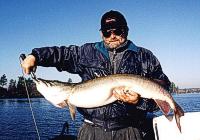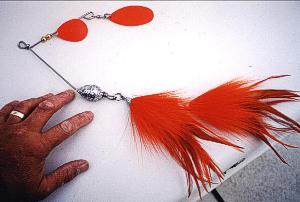SPINNERBAITS
THE #1 YEAR ROUND TACTIC FOR BIG PIKE AND MUSKIES
By Steve Wickens - Strike Zone Muskie Charters
 One of the questions that I am often asked by clients, and at shows, is
"What pike or muskie bait is the overall most effective bait for all seasons?"
There is no hesitation in my answer; it is without any doubt, the spinnerbait. One of the questions that I am often asked by clients, and at shows, is
"What pike or muskie bait is the overall most effective bait for all seasons?"
There is no hesitation in my answer; it is without any doubt, the spinnerbait.
Why is the spinnerbait so effective? There are a number of reasons. The twin blades
produce an immense amount of flash, which is a necessary visual stimulus. Those same
blades produce a level of vibration in the water that most other baits, even many with
rattles inside, simply cannot duplicate. The general rule of thumb for blades is that
wider blades, such as Colorado, provide lift. Narrower blades, such as a willowleaf
provide depth. Larger blades generate a slower spin, more drag in the water, and a louder
"thump", while smaller blades spin much faster, with much less drag, and have a
much higher vibrational pitch. What works best? It depends on so many different things,
but I try to go middle of the road for the most part, with many colour variations,
although admitting a specific preference to bright fluorescent red, orange, and chartreuse
blades. The number of different weights and blade configurations allows you to fish a
spinnerbait in so many different ways. But the real key piece of the puzzle is the hooking
effectiveness of spinnerbait. Let's face it, when a big muskie or pike chomps down on that
skirt, what are they really getting? Nothing of substance; just a mouthful of hooks! What
about hooks? Singles or trebles on that spinnerbait? I prefer singles. The reason for this
is threefold. They hook better, they are much less subject to fouling in weeds or onto
themselves, and they are much faster, easier and safer to remove from the fish later.
 For early
season fish, it is hard to top a spinnerbait that is cast and worked slowly around pockets
of emerging cabbage, around inside turns and points in thicker weeds such as milfoil or
coontail, or around transition areas where rock, gravel, or sand meet a weed covered soft
bottom. Traditionally, these areas hold fish and some surprisingly big fish, in the early
weeks of the season. Mud flats laced with clumps of vegetation and pencil reeds may hold
fish, if the area is in a shallow mud lined bay that faces south or southwest, as these
areas tend to warm faster and attract fish recuperating from the rigors of spawning. For
active fish, you can try a simple pitch 'n crank technique. Toss the bait out and retrieve
at a fairly constant but moderate speed. If you find the fish are following but won't hit,
then you have a couple of very productive ways to stimulate them into hitting. The most
exciting is putting the spinnerbait on top. As you cast the bait out, you hold your rod
tip up at roughly a 10 o'clock position, and begin your retrieve before the bait hits the
water, winding just fast enough to keep the blades breaking the surface with a clanking
and gurgling sound. A longer rod makes this a whole lot easier than with a shorter pool
stick version. You will get hits that will make your heart leap into your throat! The
other option is more of a finesse tactic that works year round. It involves working the
spinnerbait with a rise and fall action, over the weeds and into pockets or around
structures. The fall need only be a couple of feet to trigger a hit, but you must be
alert, because many strikes will come on the drop. A sharp snapping hookset will punch
those razor sharp hooks in quickly, and you're in business. For early
season fish, it is hard to top a spinnerbait that is cast and worked slowly around pockets
of emerging cabbage, around inside turns and points in thicker weeds such as milfoil or
coontail, or around transition areas where rock, gravel, or sand meet a weed covered soft
bottom. Traditionally, these areas hold fish and some surprisingly big fish, in the early
weeks of the season. Mud flats laced with clumps of vegetation and pencil reeds may hold
fish, if the area is in a shallow mud lined bay that faces south or southwest, as these
areas tend to warm faster and attract fish recuperating from the rigors of spawning. For
active fish, you can try a simple pitch 'n crank technique. Toss the bait out and retrieve
at a fairly constant but moderate speed. If you find the fish are following but won't hit,
then you have a couple of very productive ways to stimulate them into hitting. The most
exciting is putting the spinnerbait on top. As you cast the bait out, you hold your rod
tip up at roughly a 10 o'clock position, and begin your retrieve before the bait hits the
water, winding just fast enough to keep the blades breaking the surface with a clanking
and gurgling sound. A longer rod makes this a whole lot easier than with a shorter pool
stick version. You will get hits that will make your heart leap into your throat! The
other option is more of a finesse tactic that works year round. It involves working the
spinnerbait with a rise and fall action, over the weeds and into pockets or around
structures. The fall need only be a couple of feet to trigger a hit, but you must be
alert, because many strikes will come on the drop. A sharp snapping hookset will punch
those razor sharp hooks in quickly, and you're in business.
After the initial weeks of the season, right through until season close, I break out
the heavy artillery. I'm talking BIG custom spinnerbaits that dwarf most commercially made
models by as much as 50%! Many of these baits have overall weights from 3 ½ to 5 ounces,
and their tales are massive. Unless you're a serious weightlifter, you won't want to cast
these. They're designed to be trolled, and at a variety of speeds from 2 to 9 miles per
hour. Do they work? You look at the photo and tell me. During the final days of the season
in mid-November 2001, I spent a couple of days on Pigeon Lake under somewhat unseasonably
mild conditions. The end result was a pair of trophy class Kawartha muskies at 46 and 46
½ inches respectively on back-to-back days to end the season; both on spinnerbaits, and
both released.
There are three ways you can troll a spinnerbait. The first is a flat-line
presentation, where the bait runs such that the blade never breaks the surface. Of course,
the faster the boat speed, the further back the bait should be placed. Traditionally, I
have found that this is the preferred presentation for the larger fish. But sometimes a
period of record heat such as we experienced this past summer, can shut the fishing down.
As an alternate tactic, try bringing the baits in a little closer and allowing the blades
to break the surface. You can experiment so that only occasionally the blade breaks out,
or it can be a virtual surface presentation. Use this presentation along shallow weedlines
and over shallow flats and be ready, because that noise will cause havoc down below. It is
only a matter of time before your drag will be screaming. The third and final way requires
the use of a downrigger, to put one of these big spinnerbaits down deep. This presentation
is best suited for the late summer and into the early fall, but can produce some mighty
big fish if you have the patience to stick with it. Track down schools of suspended
baitfish, and run that bait around them, and even through them.
I want to touch on drag for just a second. Because spinnerbaits have no body for a fish
to get their teeth into, sharp hooks virtually guarantee a good hookset, especially when
trolling. Keep your drag loose. A drag setting in the 9 to 13 pound range is more than
ample with reasonable equipment to handle big fish. Once you go tighter on the drag, you
risk tearing the mouth, which could result in the bait working loose and falling out a
little before you'd like it to. Anyone who has experienced this will tell you that it is
not a good thing; you will kick yourself for weeks afterwards when you make such a
careless mistake.
Let me briefly touch on colour. As I said earlier, I prefer that my spinnerbaits have
bright blades. But as far as tails go, normally on darker days, I go with darker colours,
and bright colours on bright days because of the underwater silhouette factor. (For fish
looking up, the sky has an inverted colouration to what we see with our eyes.) On dark
days, I will generally start with black, brown, and perch. On bright days, I'll go with
with white, yellow, orange, chartreuse, and even hot pink. (Both of the Pigeon Lake
muskies I referred to earlier came on hot pink, so stop laughing!) The exception to this
rule is on very dark stained water, where the brighter colours may see action, regardless
of weather conditions. In a lake where visibility may be a foot or less, giving the fish
something that virtually glows in the dark may be the difference between one fish and no
fish. The easier it is for them to find it, the easier it will be for them to hit it!
This is only scratching the surface as far as what spinnerbaits can do for you if you
give them a serious try. Over the 2000 and 2001 seasons, spinnerbaits accounted for over
120 muskies in my boat, with over 70 of these in excess of 40 inches. If you are serious
about catching big pike and muskies, this is one bait that MUST become part of your
arsenal on a regular basis!
Good fishing!
Steve Wickens strike.zone@sympatico.ca
Above Left - The author with a 46" muskie from Pigeon Lake. Above
Right - The author's huge home-made Seismic spinnerbait.
|